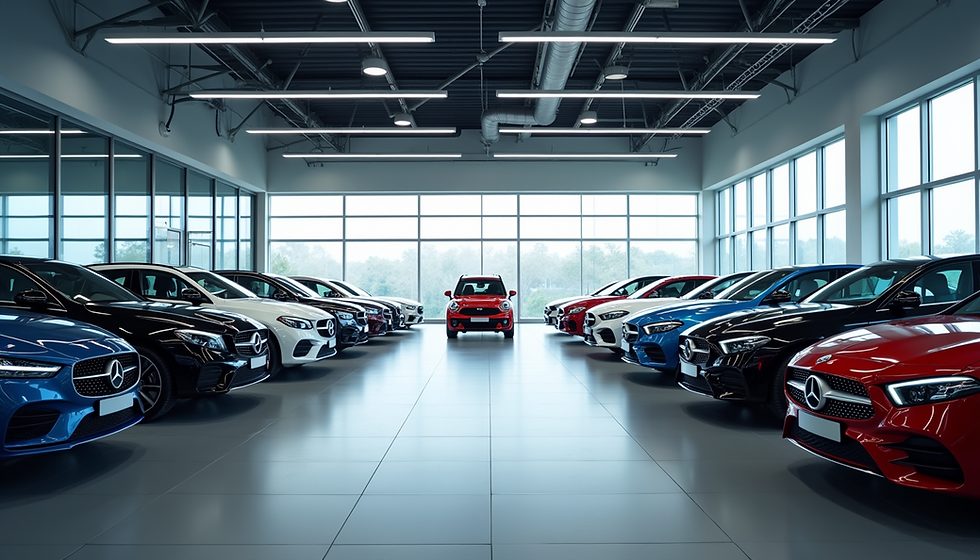What to Expect When Buying a Car Amid New Tariff Uncertainty: Should You Buy Now or Wait?
- joseph retcho
- May 1
- 5 min read

Buying a car is always a major decision, but in 2025, the landscape is more uncertain than ever due to sweeping new tariffs on imported vehicles and auto parts. If you’re wondering whether to buy now or wait, what types of vehicles will be affected, and how insurance might change, here’s a comprehensive guide to help you navigate this turbulent market.
The New Tariff Landscape: What’s Changing?
A 25% tariff on imported vehicles and key auto parts is now in effect as of April 3, 2025. This tariff applies to a wide range of imported passenger vehicles-including sedans, SUVs, crossovers, minivans, cargo vans, and light trucks-as well as critical components used in both foreign and domestic car manufacturing.
Additionally, tariffs on imported vehicle parts are set to go into effect by May 3, 2025, which will further impact production costs and, ultimately, the prices consumers pay at dealerships.
How Will Tariffs Affect Car Prices?
Significant Price Increases Expected
New Imported Cars: The most direct impact will be on new vehicles assembled outside the United States. Price hikes of $5,000 to $10,000 per vehicle are expected, with some models potentially seeing increases as high as $20,000, depending on the origin of the car and its parts.
Domestic Cars: Even vehicles assembled in the U.S. are expected to become more expensive. Many American-made cars rely on imported parts, and as those costs rise, manufacturers are likely to pass them on to consumers. Increased demand for domestic models as buyers seek to avoid tariffs may also drive prices higher.
Used Cars: While tariffs do not directly affect used vehicles, the ripple effect of higher new car prices and limited inventory will likely boost demand for used cars, pushing their prices up as well.
Timing and Inventory Uncertainty
Some dealerships still have tariff-free inventory, but it’s unclear how long this will last. Once these vehicles are sold, new stock will reflect the higher costs imposed by tariffs.
Manufacturers and dealers are adjusting their strategies, sometimes delaying imports or shifting production, which may lead to further supply shortages and price volatility.
Buy Now or Wait? Weighing the Options
Reasons to Buy Now
Avoid Imminent Price Hikes: If you need a car soon and have the budget, buying before the last of the tariff-free inventory is sold could save you thousands of dollars.
Supply Chain Uncertainty: As manufacturers and dealers adjust to the new tariffs, supply disruptions and longer wait times for certain models are likely.
Used Car Prices Will Rise Too: Waiting may not save you money if the used car market tightens and prices climb in response to higher new car costs.
Reasons to Wait
Potential Incentives: Dealers may offer short-term incentives to clear existing inventory, especially if demand drops due to sticker shock. However, these incentives may be limited and short-lived.
Market Adjustments: Over time, manufacturers might find ways to mitigate costs-such as increasing U.S. production or sourcing parts domestically-which could stabilize prices, but this process could take months or years.
Policy Changes: Trade policy is inherently political and subject to change. If tariffs are reduced or eliminated, prices could eventually decline, though there’s no guarantee when or if this will happen.
Most experts recommend buying sooner rather than later if you have already decided to purchase a car and can afford it. The risk of substantial price increases and inventory shortages outweighs the potential benefits of waiting for a better deal in the near term.
Which Cars Are Most Likely to Be Affected?
Vehicles Directly Impacted by Tariffs
Vehicle Type/Origin | Tariff Impacted? | Notes |
Imported passenger vehicles (Europe, Asia, etc.) | Yes | Includes sedans, SUVs, crossovers, minivans, cargo vans, light trucks |
Vehicles assembled in Canada/Mexico | Yes | Tariffs apply unless exempted by specific trade agreements |
U.S.-assembled vehicles (with imported parts) | Indirectly | Higher costs due to tariffs on parts; prices likely to rise |
U.S.-assembled vehicles (with domestic parts) | No/Minimal | Least affected; check assembly and parts origin before buying |
Popular Models Assembled in the U.S. (Less Affected):
Many Toyota, Ford, Honda, and Chevrolet models are assembled in the U.S. and may avoid the direct impact of tariffs, though parts costs could still rise.
Imported Luxury and Specialty Vehicles:
Brands like BMW, Mercedes-Benz, Audi, and certain Japanese models are likely to see the steepest price increases due to their reliance on foreign assembly and parts.
Insurance Implications: What Will Happen to Premiums?
Why Car Insurance Costs Will Rise
Higher Vehicle Values: As car prices rise, so do the values insurers must cover in the event of a total loss, leading to higher premiums.
Increased Repair Costs: Tariffs on parts mean repairs will be more expensive, and insurers will pass these costs on to consumers through higher rates.
Industry-Wide Impact: The increase in claims costs will be reflected in premium hikes across the industry.
Projected Increases
Average Premium Hike: Car insurance premiums are expected to rise by 8% to 19% by the end of 2025, depending on how long tariffs remain in place and how much they disrupt supply chains.
Annual Cost: The average annual premium could climb significantly compared to previous years.
Other Factors
Longer Repair Times: Disruptions in the supply of parts could mean longer waits for repairs, potentially resulting in higher rental car costs and extended inconvenience for policyholders.
Used Car Values: As used car prices rise, so too will the cost to insure them, since insurers base premiums in part on the market value of the vehicle.
Practical Tips for Buyers in 2025
1. Research Vehicle Origins
Check where the car is assembled and where its major components come from. U.S.-built cars with mostly domestic parts will be less affected by tariffs.
2. Move Quickly if You’re Ready
If you’ve already decided to buy, act soon to take advantage of remaining tariff-free inventory and avoid expected price hikes.
3. Consider Used Cars, But Don’t Wait Too Long
Used car prices will rise as new car prices climb, but there may be a temporary window before the full effects of the tariffs filter through the market.
4. Shop Around for Insurance
Compare insurance rates and consider bundling policies or raising deductibles to offset higher premiums.
5. Prepare for Higher Ownership Costs
Budget not just for a higher purchase price, but also for increased insurance, maintenance, and repair costs due to more expensive parts.
Navigating Uncertainty
The 2025 auto market is defined by uncertainty, with new tariffs set to raise prices on a wide range of vehicles and parts. If you need a car soon, buying now may help you avoid the steepest price increases and limited inventory that are likely to follow as the tariffs take full effect. However, if you can wait and are willing to monitor the market closely, there may be opportunities for incentives or for manufacturers to adapt over time.
Regardless of your decision, expect higher insurance premiums and prepare for the possibility of longer repair times and higher maintenance costs. In this environment, diligent research and quick action are your best tools for minimizing the impact of these sweeping changes.
Key Takeaways:
Tariffs will raise prices on most imported vehicles and parts, with ripple effects on domestic models and used cars.
Car insurance premiums are set to rise by up to 19% in 2025 as repair and replacement costs increase.
If you’re ready to buy, acting quickly may save you thousands; if you wait, be prepared for continued volatility and higher costs across the board.
Stay informed, compare your options, and act decisively to get the best deal possible in this rapidly changing market.




Comments